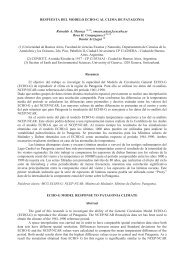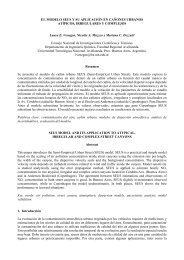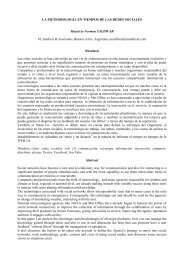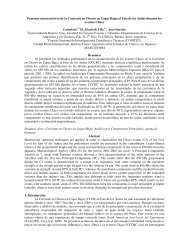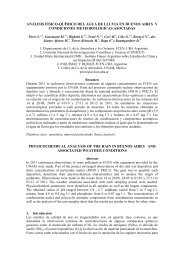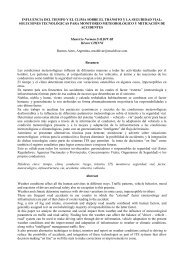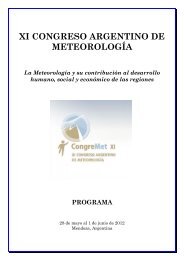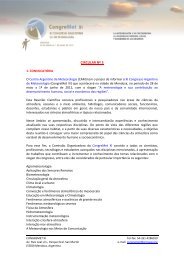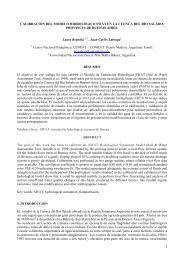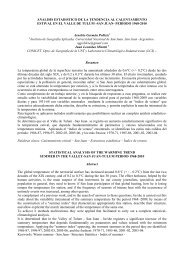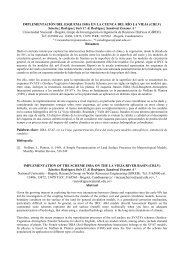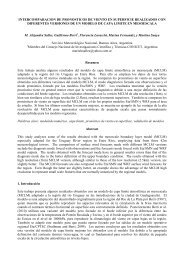EVALUACIÃN DEL MODELO FALL3D-6.2 PARA TRES CASOS DE ...
EVALUACIÃN DEL MODELO FALL3D-6.2 PARA TRES CASOS DE ...
EVALUACIÃN DEL MODELO FALL3D-6.2 PARA TRES CASOS DE ...
You also want an ePaper? Increase the reach of your titles
YUMPU automatically turns print PDFs into web optimized ePapers that Google loves.
EVALUACIÓN <strong><strong>DE</strong>L</strong> MO<strong><strong>DE</strong>L</strong>O <strong>FALL3D</strong>-<strong>6.2</strong> <strong>PARA</strong> <strong>TRES</strong> <strong>CASOS</strong> <strong>DE</strong> ESTUDIO:<br />
VOLCANES HUDSON, CHAITÉN Y CORDÓN <strong><strong>DE</strong>L</strong> CAULLE.<br />
María Soledad Osores (1),(2 , ) Estela Collini, (1),(2) , Paola Salio (3) , Arnau Folch (4) , José G.<br />
Viramonte (5) , Gloria Pujol, (1) , Diana Rodríguez (1)<br />
(1) Servicio Meteorológico Nacional, Argentina<br />
(2) Servicio de Hidrografía Naval, Argentina<br />
(3) Departamento de Ciencias de la Atmósfera y los Océanos, FCEYN, UBA, Argentina.<br />
(4) Barcelona Supercomputing Centre, Barcelona, España<br />
(5) CONICET-Universidad Nacional de Salta, Argentina<br />
soledad_osores@hotmail.com<br />
Resumen<br />
Basado en la gran cantidad de volcanes geológicamente activos ubicados en Chile y Argentina, este<br />
trabajo se focalizó en el modelado de la dispersión y depósito de ceniza empleando el modelo euleriano<br />
<strong>FALL3D</strong>-<strong>6.2</strong> para tres erupciones que impactaron fuertemente la Patagonia Argentina en los últimos 21<br />
años, originadas por los volcanes: Hudson (Agosto 1991), Chaitén (Mayo 2008) y Cordón del Caulle<br />
(Junio 2011) respectivamente.<br />
Para ello, se acopló el modelo <strong>FALL3D</strong>-<strong>6.2</strong> al modelo meteorológico de mesoescala WRF-ARW. En el<br />
caso de la erupción más antigua se realizó a modo diagnóstico empleando los datos del ERA Interim<br />
del ECMWF, como condiciones iniciales y de borde del WRF-ARW; mientras que el Chaitén y<br />
Cordón del Caulle, se realizaron a modo pronóstico empleando los ciclos del GFS para inicializar y<br />
brindar las condiciones de borde al WRF-ARW. Los dos últimos casos se realizaron empleando la<br />
opción de reinicialización del <strong>FALL3D</strong>-<strong>6.2</strong> que inicializa cada nuevo procesamiento con los campos<br />
3D de concentración de ceniza y 2D de depósito total resultantes de la corrida anterior.<br />
Se utilizaron diversas metodologías para la estimación de la altura de columna eruptiva, tales como la<br />
combinación de radiosondeos e imágenes de topes nubosos, datos observacionales, artículos científicos,<br />
entre otras. Las granulometrías para cada evento fueron estimadas “in situ” para el Cordón del Caulle y<br />
partir de publicaciones especializadas en los casos antiguos.<br />
Los criterios de evaluación de los pronósticos del <strong>FALL3D</strong>-<strong>6.2</strong> dependieron del material disponible<br />
en la época de la erupción. En el caso del volcán Hudson, la validación de la ubicación de la nube de<br />
ceniza se realizó mediante las imágenes del sensor TOMS del satélite Nimbus 7 publicadas en otro<br />
artículo, donde a partir de la detección de SO2 ligado a la nube volcánica y el índice aerosol (AI)<br />
pudieron seguir la trayectoria de la nube. Para el Chaitén y Cordón del Caulle se emplearon las<br />
imágenes de diferencia de temperatura de brillo (BTD) de los sensores MODIS y AVHRR de los<br />
satélites AQUA/TERRA y NOAA 15-16-19 respectivamente. Para la validación de los depósitos de<br />
ceniza modelados se emplearon los mapas isopáquicos calculados por diversos autores.<br />
En general se logró un buen ajuste en la ubicación de la pluma volcánica en los distintos casos. En<br />
ocasiones la nube de ceniza modelada no representó ciertos patrones nubosos probablemente asociados<br />
a procesos difusivos. En cuanto al depósito, la comparación con las isopacas muestreadas en campo<br />
presentó buena concordancia para los volcanes Hudson y Chaitén. Para el Cordón del Caulle, en<br />
cambio, no se obtuvo el patrón identificado por el campo isopáquico probablemente debido al menor<br />
detalle temporal de la altura de columna, como así también a la subestimación del tamaño de las<br />
partículas en el cálculo de la distribución total.<br />
Palabras clave: dispersión de ceniza, depósito, modelado numérico, validación.
EVALUATION OF THE <strong>FALL3D</strong>-<strong>6.2</strong> MO<strong><strong>DE</strong>L</strong> FOR THREE CASES OF STUDY: HUDSON,<br />
CHAITÉN AND CORDÓN <strong><strong>DE</strong>L</strong> CAULLE VOLCANOES<br />
Abstract<br />
Based on the large amount of active volcanoes located in Chile and Argentina, this work is focused on<br />
the modeling of volcanic ash dispersion and deposit applying the eulerian model <strong>FALL3D</strong>-<strong>6.2</strong> to three<br />
main eruptions that occurred in Patagonia in the past 21 years, they are from Hudson (August 1991),<br />
Chaitén (May 2008) and Cordón del Caulle (June 2011) volcanoes.<br />
Simulations were performed using the <strong>FALL3D</strong>-<strong>6.2</strong> dispersion model coupled with the WRF-ARW<br />
meteorological model. In the Hudson case, which was the oldest eruption, WRF-ARW was run in<br />
diagnostic mode using ERA-INTERIM data set from ECMWF as initial field and boundary conditions,<br />
while in case of Chaitén and Cordón del Caulle the meteorological model was run in forecast mode<br />
using the GFS as initial field and boundary conditions. In the last two cases, the <strong>FALL3D</strong>-<strong>6.2</strong> restart<br />
option was used, where each run is initialized with the tridimensional volcanic ash concentrations and<br />
bidimensional deposit fields resulting from the previous run.<br />
Different methodologies were used to estimate the eruptive column height, using a combination of<br />
rawinsonde and cloud top images, observations, scientific articles among others. The granulometry for<br />
each event were estimated “in situ” for the Cordón del Caulle and from scientific articles for the older<br />
cases.<br />
The model results evaluation also depend on the information available at the time of the eruption. For<br />
the Hudson case, the localization of the ash cloud was made using images already published from<br />
sensor TOMS on board of the satellite NIMBUS 7, where from the detection of SO 2 present in the ash<br />
cloud and the AI aerosol index, the cloud track can be determined. In case of Chaitén and Cordón del<br />
Caulle, the comparison was made with sequences of MODIS and AVHRR sensors from the<br />
AQUA/TERRA and NOAA 15-16-19 respectively, using ash detection algorithms based on the 11-12<br />
µm channels Brightness Temperature Difference (BTD). In addition, deposit thickness measurements<br />
from field campaigns were used to validate the modeled ash deposits.<br />
The model results show a good representation of the localization of the volcanic ash. In few occasions,<br />
the modelled ash cloud does not represent cloudy patterns probably associated with diffusive processes.<br />
The forecasted ash deposits show a good agreement with the obtained from the field campaign<br />
measurements in the case of Hudson and Chaitén. Meanwhile, for the Cordón del Caulle, it was not<br />
posible to identify a pattern associated with the isopachs field calculated from the measurements. This<br />
is probably due to the lack of temporal discrimination of the eruptive column height, as well as the<br />
subestimation of the particles size in the total distribution calculations.



